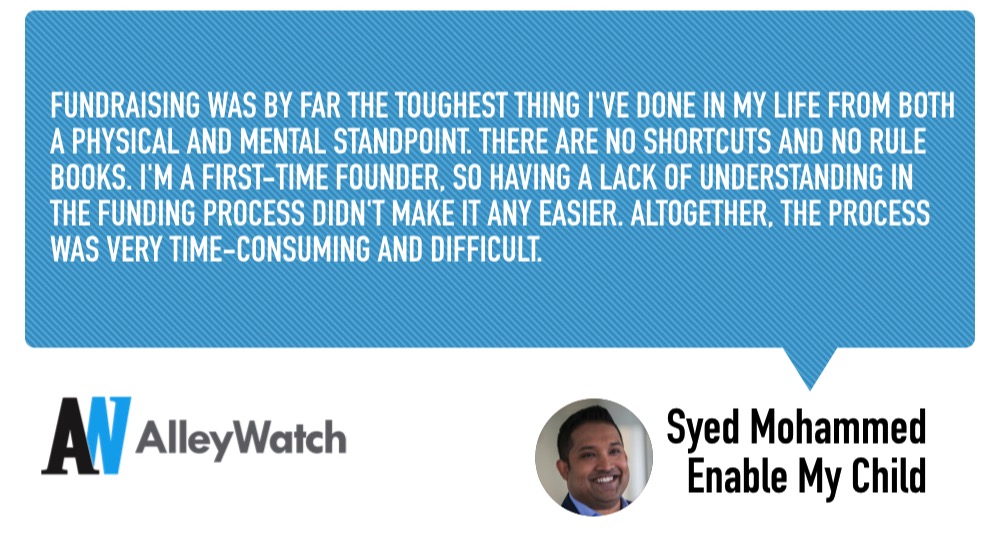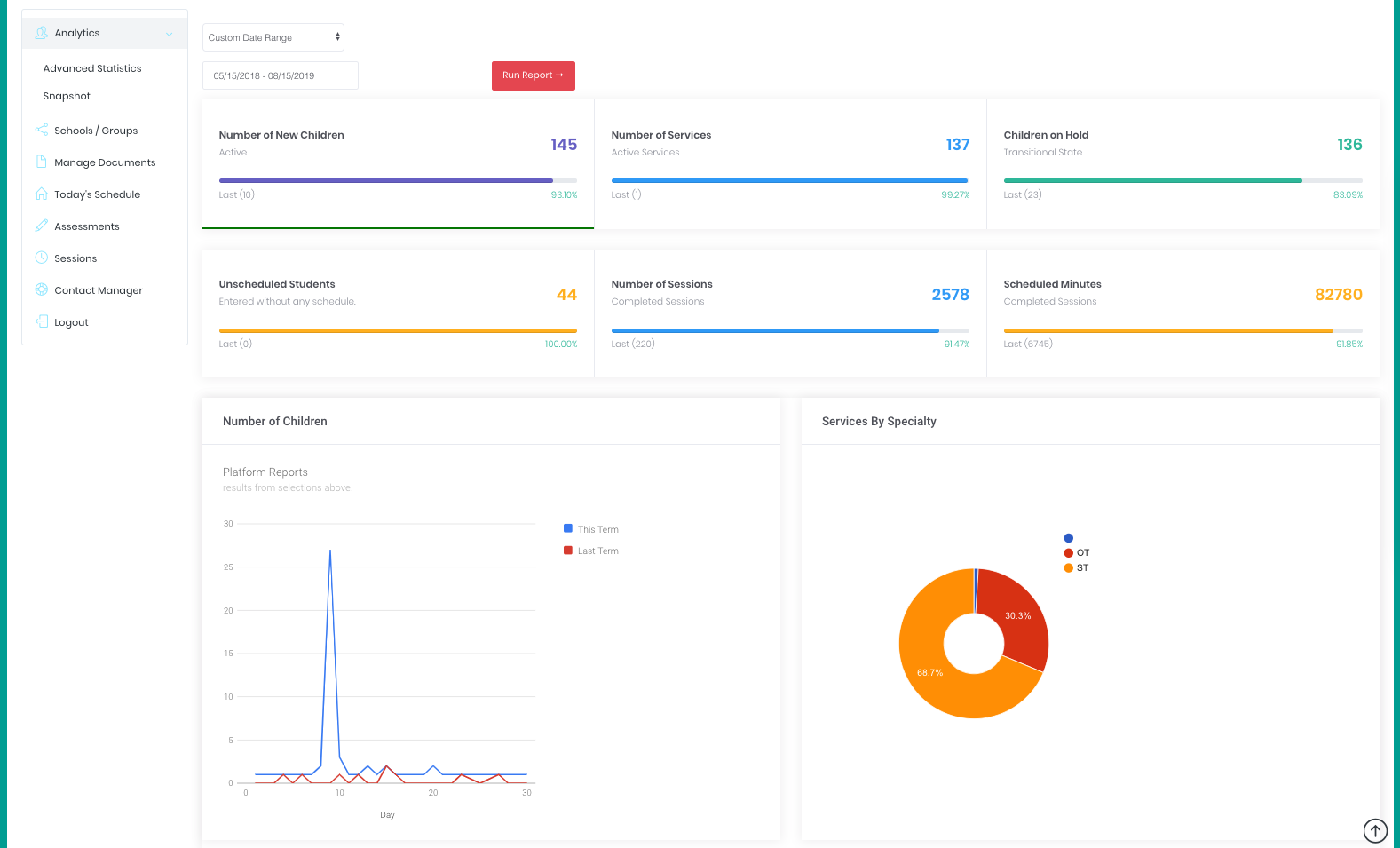While many schools offer school-based therapy services, budgetary pressures almost always ensure that these services are the first to go. Accessibility to services like speech, physical, occupational, and behavioral therapy can be instrumental in a child’s development especially during the transformative years. Arising from the founder’s personal experience, Enable My Child is a technology-enabled platform that provides children with access to licensed therapists. Focusing on evidence-based therapy, the company, which was founded in 2017, leverages AI through what it calls EMC Brain to build a repository of treatment protocols that can be used for future evaluations.
AlleyWatch sat down with CEO and Founder Syed Mohammed to learn about his journey to launch Enable My Child, the company’s growth plans, and first institutional round of funding.
Who were your investors and how much did you raise?
We raised $1.2 million in a seed round of financing led by CMI Ventures, but we also received support from strategic angel investors as well, including NYC-based investor Arie Abecassis.
Tell us about the product or service that Enable My Child offers.
Enable My Child provides high-quality speech, physical, occupational and behavioral therapy services for children. We connect our patients with licensed therapists who can correctly diagnose and provide treatment in all stages of development from infancy to adolescence. Our proprietary technology the EMC Brain serves as a vehicle for therapy, anonymously catalogs treatment methods from each case, and delivers suggestions for future patients with similar profiles, which allows us to provide therapy that is tailored and highly effective.
What inspired you to start Enable My Child?
Growing up, I struggled to keep up in school. It wasn’t until I was diagnosed with ADHD in my thirties that I realized why some tasks are more difficult for me. At that point, I started going to therapy and realized just how transformational it is. I thought about what it would have been like if I had been diagnosed and treated as a child. It would have made a world of a difference, so with my own experience as the driving force, I launched Enable My Child.
 How is Enable My Child different?
How is Enable My Child different?
The term “teletherapy” is used often in the telehealth space, but Enable My Child is much more than a teletherapy provider. In addition to virtual sessions, we also offer in-person and hybrid sessions through our network of more than 100 pediatric therapists.
Unlike many teletherapy providers, we don’t rely on a video conferencing service like Zoom or Skype for internet-enabled voice and video. The EMC Brain is capable of performing a variety of analytical tasks, such as automated billing, scheduling, attendance tracking, and document filing, as well as accomplishing intuitive functions. Also, unlike many video and web conferencing platforms, the EMC Brain has multiple layers of military-grade security and adheres to HIPAA- and FERPA-compliance requirements to protect children’s personal information.
What market does Enable My Child target and how big is it?
According to a report from the Centers for Disease Control and Prevention (CDC), one in six children aged 2 to 8 years old has a mental, behavioral, or developmental disorder. Unfortunately, despite federal and state regulations in schools, millions of children aren’t receiving proper treatment. Therapy is especially important in the early years of a child’s life, as during that time brain development occurs at an intense pace. Children who don’t receive treatment for their specific needs often need life-long support from their parents and family members.
By removing the barriers to treatment, we will not only transform the lives of millions of children but impact entire communities, as well.
What’s your business model?
We contract directly with the special education departments at our partner schools, which allows us to charge less for our services but still provide the best possible therapy solutions for our patients. All clients are billed hourly based on usage.
Because we hire our therapists, we pay them more than the industry standard. All in all, almost 70 percent of our earnings go to our therapists.
Who do you consider to be your main competitors?
PresenceLearning, TinyEYE, and VocoVision are a few of the big players in the pediatric teletherapy space. But unlike many of our competitors, our platform is more than a video call service or platform for delivering therapy. The EMC Brain utilizes AI to analyze data and provide insights to therapists about which treatments have been most effective in similar cases. This allows the technology to grow smarter, so over time the EMC Brain will only become better and even more effective.
Our proprietary technology is only one piece of the puzzle in our comprehensive offerings. We provide schools with any service they may need, including access to social workers. Each school is assigned a Care Coordinator (CC), who provides support to administrators, staff, and families. The CC also handles questions regarding scheduling, billing, and any other concerns.
What was the funding process like?
Fundraising was by far the toughest thing I’ve done in my life from both a physical and mental standpoint. There are no shortcuts and no rule books. I’m a first-time founder, so having a lack of understanding in the funding process didn’t make it any easier. Altogether, the process was very time-consuming and difficult.
If I could offer some advice to other first-time founders, I’d say to remember that you’re facing the same challenges all entrepreneurs face. In the grand scheme of things, you aren’t in a disadvantageous position. With every pitch, you will learn something new and implement it in your pitch and your deck if it’s applicable. This very process of evolving will be key to taking you across the finish line.
What are the biggest challenges that you faced while raising capital?
The biggest challenge was properly presenting our business succinctly and effectively. We had to find a way to share the most important aspects of the business so investors could quickly grasp how our business works, as well as its underlying economics. As we learned, presenting the right amount of information in the right flow is crucial to increasing the rate of investors who want to talk to you after that first call.
What factors about your business led your investors to write the check?
There were two big factors. The first was that we implemented feedback from investors after every meeting and tweaked our pitch accordingly. By the time we met with our current investors, we had honed our pitch and were able to deliver a message that ultimately led to our seed funding.
Another factor was our transparency. We showed our business for what it is rather than overselling it for what it’s not. This allowed us to gain our investors’ confidence at the beginning of the relationship.
What are the milestones you plan to achieve in the next six months?
We plan to both increase the adoption of teletherapy amongst our existing partner schools and our reach to parents through early intervention centers.
In the future, we plan on expanding our consumer-facing services, so parents and guardians can also receive access to similar services we’re offering schools and early intervention centers.
What advice can you offer companies in New York that do not have a fresh injection of capital in the bank?
- Find an incubator or advisor. You’ll need one to help you understand the game and its rules. I couldn’t have completed my seed round without my advisor making introductions and helping me understand the “hows” of the process.
- Take a targeted approach. Create a list of investors who are investing in your vertical/landscape. Most investors focus on specific sectors and they won’t consider companies outside of those. You can find this information by simply looking at the companies they’ve invested in, which is typically found on the investor’s website.
- Stop reading from your deck! Investors will read your deck before they get on the phone with you. When you pitch, focus on telling a story rather than reading every line from your notes.
Where do you see the company going now over the near term?
We plan on expanding our partnerships with early intervention centers and schools as we expand into more states. By taking these small steps, we are on the path to achieving our long-term goal, which is to increase access to high-quality pediatric therapy so hundreds and thousands—and eventually millions—of children can overcome their obstacles and maximize their potential for success.
What’s your favorite restaurant in the city?
My favorite restaurant is Gramercy Tavern in the Flatiron District.






